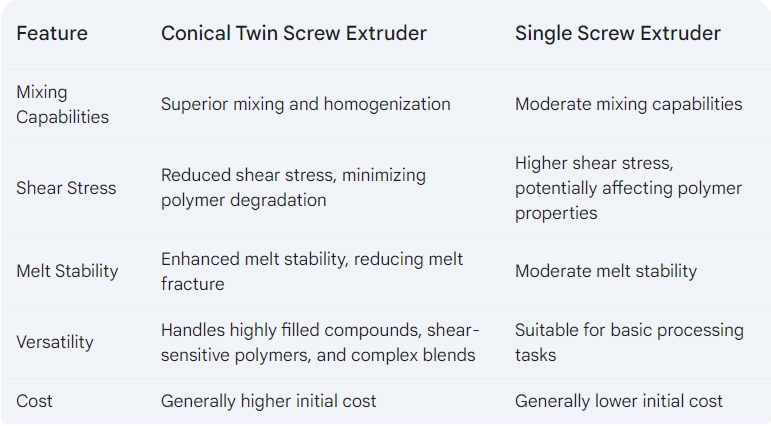In the realm of plastics processing, extruders play a pivotal role in shaping and transforming polymers into various products. Among the diverse extruder types, conical twin screw extruders (CTSEs) and single screw extruders (SSEs) stand out as prominent choices. While both types serve the common purpose of polymer processing, they exhibit distinct characteristics and capabilities that make them suitable for different applications. This comprehensive guide delves into the world of CTSEs and SSEs, exploring their unique features, advantages, and the applications where they excel.
Conical Twin Screw Extruders: A Symphony of Mixing and Efficiency
Conical twin screw extruders (CTSEs) are renowned for their exceptional mixing capabilities and versatility in handling demanding applications. Their defining feature is the conical barrel design, where the barrel diameter gradually decreases towards the discharge end. This unique geometry promotes intense mixing and homogenization of polymer blends, additives, and fillers, ensuring a uniform distribution of materials throughout the melt.
Advantages of Conical Twin Screw Extruders:
Enhanced Mixing and Homogenization: CTSEs excel at producing high-quality products with consistent properties and performance, making them ideal for applications requiring superior mixing.
Reduced Shear Stress: The conical design minimizes shear stress on the polymer melt, preventing polymer degradation and ensuring product quality, particularly for shear-sensitive polymers.
Improved Melt Stability: CTSEs enhance melt stability, reducing the risk of melt fracture and ensuring a smooth, consistent extrusion process, crucial for producing products with uniform dimensions and surface properties.
Versatility for Demanding Applications: CTSEs handle highly filled compounds, shear-sensitive polymers, and complex polymer blends, making them suitable for demanding applications like wire and cable insulation, medical plastics, automotive plastics, packaging, and compounding/masterbatching.
Single Screw Extruders: Simplicity and Cost-Effectiveness
Single screw extruders (SSEs) represent the workhorse of the plastics processing industry, offering a simple and cost-effective solution for a wide range of applications. Their design features a single screw rotating within a cylindrical barrel, conveying, melting, and shaping the polymer.
Advantages of Single Screw Extruders:
Simple Design and Operation: SSEs offer a straightforward design and operation, making them easy to maintain and less susceptible to breakdowns.
Cost-Effectiveness: SSEs are generally more affordable than CTSEs, particularly for applications where complex mixing or handling of challenging materials is not required.
Suitable for Basic Processing: SSEs excel at basic polymer processing tasks like pelletizing, compounding, and producing simple profiles, making them suitable for cost-sensitive applications.
Choosing the Right Extruder: A Matter of Application and Needs
The decision between a conical twin screw extruder (CTSE) and a single screw extruder (SSE) hinges on the specific application and processing requirements. For applications demanding superior mixing, reduced shear stress, improved melt stability, and the ability to handle challenging materials, CTSEs are the preferred choice. However, for basic processing tasks and cost-sensitive applications, SSEs offer a viable and economical solution.
Conclusion: Navigating the Extruder Landscape
The choice between a conical twin screw extruder (CTSE) and a single screw extruder (SSE) is not a one-size-fits-all decision. Carefully evaluate the specific application, processing requirements, and budget constraints to determine the most suitable extruder type. For demanding applications where superior mixing, product quality, and the ability to handle challenging materials are paramount, CTSEs emerge as the clear choice. However, for basic processing tasks and cost-sensitive applications, SSEs offer a practical and economical solution. By understanding the strengths and limitations of each extruder type, processors can make informed decisions that optimize their operations and achieve desired product quality.
Post time: Jun-27-2024






